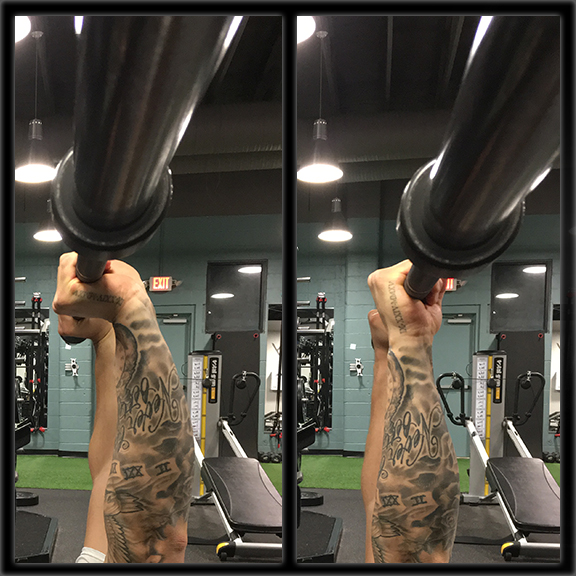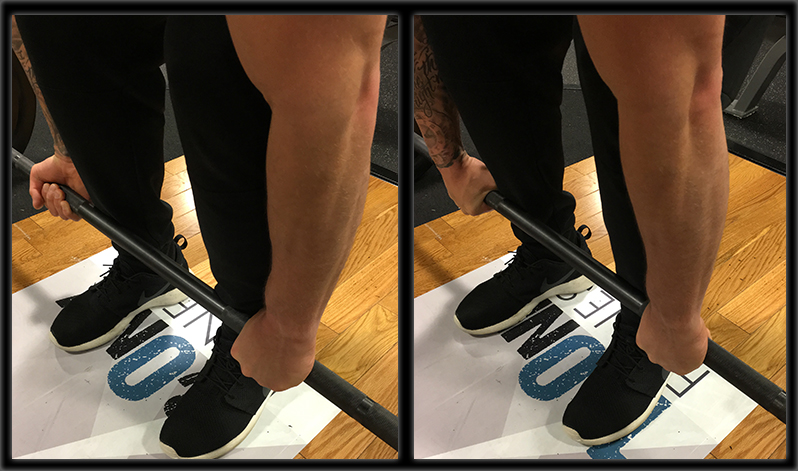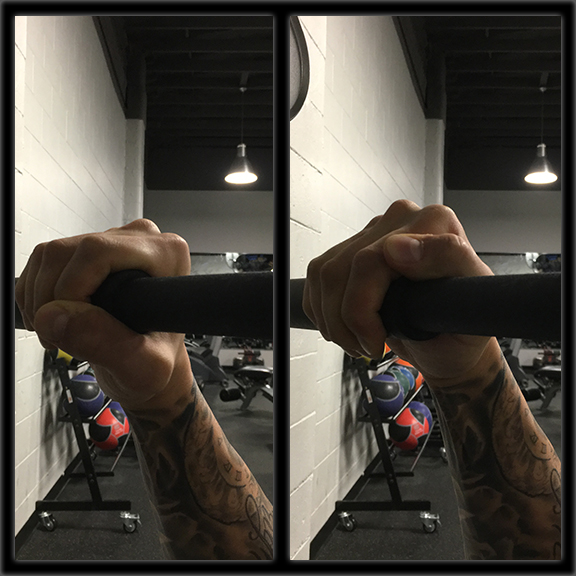3 Grip Mistakes Undermining Your Bench Press, Deadlift and Lat Pulldowns
![]()
The stronger the grip, the stronger the man (or woman). Grip strength is one of the most overlooked aspects of training, yet it’s far more more important than people realize. Numerous studies have found that exercise grip strength is a powerful indicator of one’s overall health. And several top strength and conditioning coaches use grip tests to analyze an athlete’s recovery speed when coming back from an injury.
When you are lifting, your grip can enhance—or ruin—your ability to perform an exercise. Slight tweaks to the positioning of your hand, wrist angle or thumb can dramatically affect your movement during an exercise, and the weight you can use during it.
In my own training, I’ve see a lot of exercise grip mistakes, but three seem the most common. The good news is that they are all pretty easy to fix, and that correcting them will pay huge dividends. Don’t let your own hands be the thing that holds you back. Fix these three issues today.
Grip Mistake #1: Limp Wrists on the Bench
Limp-wristed benching is by far the most common exercise grip mistake I see, and I see it when people perform Barbell or Dumbbell Bench Press. You’ve probably seen this issue—maybe you even own it. I know I did for years. The limp wrist is pictured on the left side in the photo below:

Limp-Wristed Grip on Bench Press (L); Proper Grip (R)
Lifters with this issue make the mistake of letting their palms face up rather than their knuckles. Why? Lack of wrist stability and grip strength are the primary reasons. But it could be that the person just never learned the right way. Or maybe they have, but they’re having a tough time breaking a bad habit.
To fix this, focus on keeping your wrists neutral and your knuckles pointing straight up toward the ceiling. I use the cue, “Punch it up,” when coaching the Bench Press, and I mean exactly that. Each rep should move like a jab—quick, powerful and precise. You wouldn’t want to land a punch with the inside of your wrist. You want your knuckles facing the target. The same is true with your Bench Press. Punch the weight up, leading with your knuckles.
I’ve seen clients add as much as 15 pounds to their Bench Press max simply by fixing this simple grip mistake. If you’re benching with limp wrists, try this out immediately.
Grip Mistake #2: Using Only a Mixed Grip on Deadlifts
A mixed grip on the Deadlift—one hand with an overhand grip, he other underhand—is common practice, and though it’s not necessarily harmful, it can be. Using a mixed grip every time you deadlift can lead you to develop imbalances throughout your body. How? The side using the underhand grip tends to have a slight forward lean. That causes a subtle but very real twisting motion in your body. That twisting increases the shear forces on your spine, which is never a good thing—especially when you have a hefty load on the bar, as people often do when they deadlift.
Another imbalance that may occur is in the biceps. The underhand side uses way more bicep than the overhand side.

Mixed Grip on the Deadlift (L); Double Overhand Grip (R)
The mixed grip is not “wrong” or “bad” per se, but I believe that the hook grip—in which you encase your thumb between the bar and your first two to three fingers—is the best one to use when performing Deadlifts. For many, this will feel uncomfortable, and for some, it’s just not possible. But give it a try. You’ll likely find that you can lift more weight, and do so more securely, with the hook grip. The double-overhand grip is a good way to start working toward the hook grip.
If you decide to stick with the mixed grip, at least you should alternate the overhand/underhand sides with every set.
Grip Mistake #3: Closed Thumb on Lat Pulldowns
If you grip the bar with closed thumbs during Lat Pulldowns, you might be limiting the involvement of the muscle you’re trying to work, your lats.
While this may seem contradictory, to better engage you back muscles during this exercise, you should remove your thumbs from the equation. Doing so places more of the work of moving the load onto your lats and surrounding back muscles, rather than your arms.

Closed Thumb on the Lat Pulldown (L); Open Thumb (R)
Many people struggle with the Lat Pulldown because their arms fatigue before their back muscles do. When this happens, you end a set with minimal stimulus of the targeted muscle, since the closed grip engages the musculature of your lower arms. Instead, let your thumb be free. This allows you to disengage your forearms and biceps, pulling the weight down with your lats primarily. The first pull in the exercise should be initiated from your back.
Make these three tweaks to your training and you’ll notice almost immediate benefits.
[cf]skyword_tracking_tag[/cf]RECOMMENDED FOR YOU
MOST POPULAR
3 Grip Mistakes Undermining Your Bench Press, Deadlift and Lat Pulldowns
![]()
The stronger the grip, the stronger the man (or woman). Grip strength is one of the most overlooked aspects of training, yet it’s far more more important than people realize. Numerous studies have found that exercise grip strength is a powerful indicator of one’s overall health. And several top strength and conditioning coaches use grip tests to analyze an athlete’s recovery speed when coming back from an injury.
When you are lifting, your grip can enhance—or ruin—your ability to perform an exercise. Slight tweaks to the positioning of your hand, wrist angle or thumb can dramatically affect your movement during an exercise, and the weight you can use during it.
In my own training, I’ve see a lot of exercise grip mistakes, but three seem the most common. The good news is that they are all pretty easy to fix, and that correcting them will pay huge dividends. Don’t let your own hands be the thing that holds you back. Fix these three issues today.
Grip Mistake #1: Limp Wrists on the Bench
Limp-wristed benching is by far the most common exercise grip mistake I see, and I see it when people perform Barbell or Dumbbell Bench Press. You’ve probably seen this issue—maybe you even own it. I know I did for years. The limp wrist is pictured on the left side in the photo below:

Limp-Wristed Grip on Bench Press (L); Proper Grip (R)
Lifters with this issue make the mistake of letting their palms face up rather than their knuckles. Why? Lack of wrist stability and grip strength are the primary reasons. But it could be that the person just never learned the right way. Or maybe they have, but they’re having a tough time breaking a bad habit.
To fix this, focus on keeping your wrists neutral and your knuckles pointing straight up toward the ceiling. I use the cue, “Punch it up,” when coaching the Bench Press, and I mean exactly that. Each rep should move like a jab—quick, powerful and precise. You wouldn’t want to land a punch with the inside of your wrist. You want your knuckles facing the target. The same is true with your Bench Press. Punch the weight up, leading with your knuckles.
I’ve seen clients add as much as 15 pounds to their Bench Press max simply by fixing this simple grip mistake. If you’re benching with limp wrists, try this out immediately.
Grip Mistake #2: Using Only a Mixed Grip on Deadlifts
A mixed grip on the Deadlift—one hand with an overhand grip, he other underhand—is common practice, and though it’s not necessarily harmful, it can be. Using a mixed grip every time you deadlift can lead you to develop imbalances throughout your body. How? The side using the underhand grip tends to have a slight forward lean. That causes a subtle but very real twisting motion in your body. That twisting increases the shear forces on your spine, which is never a good thing—especially when you have a hefty load on the bar, as people often do when they deadlift.
Another imbalance that may occur is in the biceps. The underhand side uses way more bicep than the overhand side.

Mixed Grip on the Deadlift (L); Double Overhand Grip (R)
The mixed grip is not “wrong” or “bad” per se, but I believe that the hook grip—in which you encase your thumb between the bar and your first two to three fingers—is the best one to use when performing Deadlifts. For many, this will feel uncomfortable, and for some, it’s just not possible. But give it a try. You’ll likely find that you can lift more weight, and do so more securely, with the hook grip. The double-overhand grip is a good way to start working toward the hook grip.
If you decide to stick with the mixed grip, at least you should alternate the overhand/underhand sides with every set.
Grip Mistake #3: Closed Thumb on Lat Pulldowns
If you grip the bar with closed thumbs during Lat Pulldowns, you might be limiting the involvement of the muscle you’re trying to work, your lats.
While this may seem contradictory, to better engage you back muscles during this exercise, you should remove your thumbs from the equation. Doing so places more of the work of moving the load onto your lats and surrounding back muscles, rather than your arms.

Closed Thumb on the Lat Pulldown (L); Open Thumb (R)
Many people struggle with the Lat Pulldown because their arms fatigue before their back muscles do. When this happens, you end a set with minimal stimulus of the targeted muscle, since the closed grip engages the musculature of your lower arms. Instead, let your thumb be free. This allows you to disengage your forearms and biceps, pulling the weight down with your lats primarily. The first pull in the exercise should be initiated from your back.
Make these three tweaks to your training and you’ll notice almost immediate benefits.











